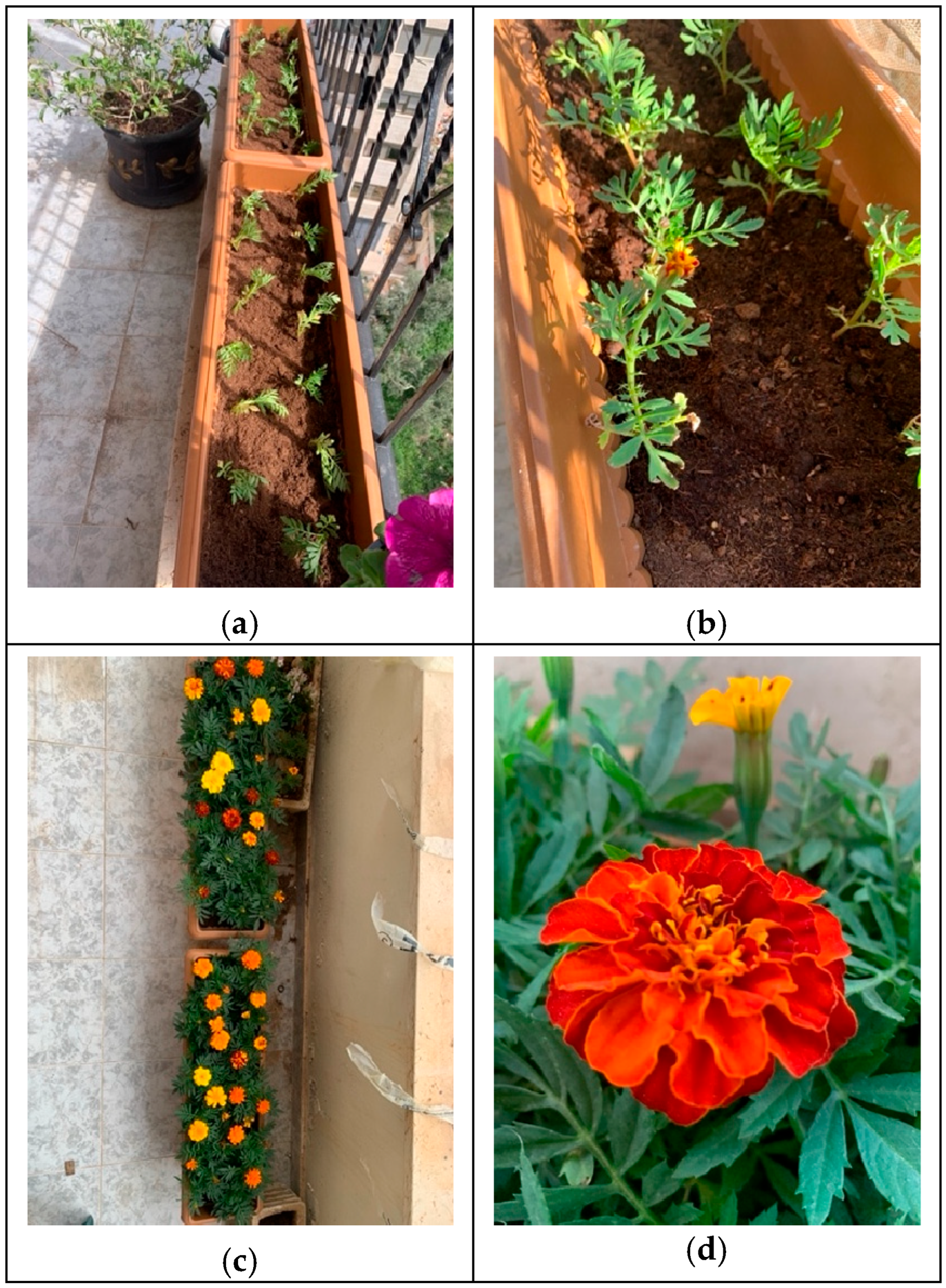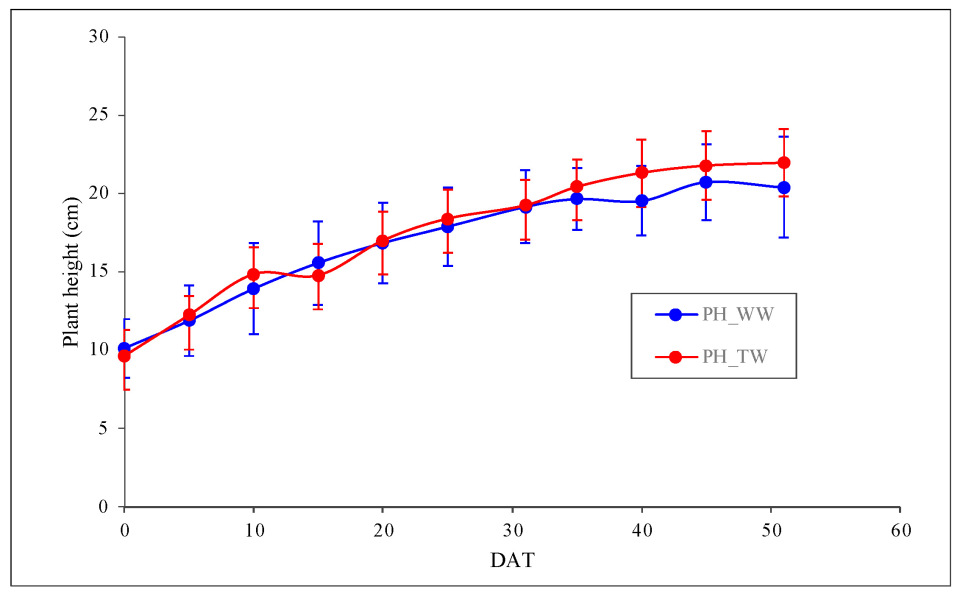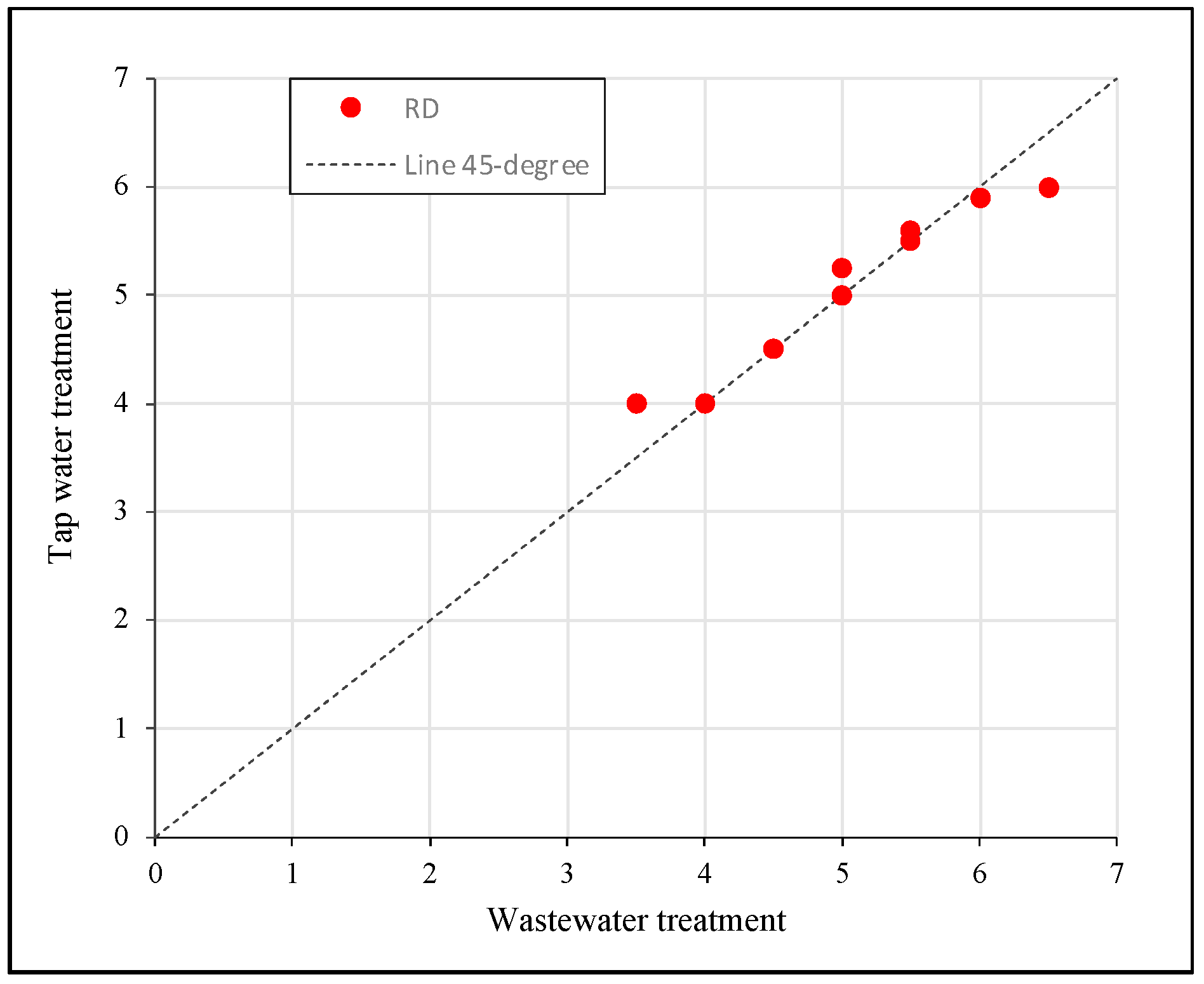Application of Treated Wastewater for Cultivation of Marigold Roses (Tagetes erecta) in a Semi-Arid Climate in Palestine
Abstract
1. Introduction
2. Materials and Methods
3. Results and Discussion
3.1. Quality of Reused Wastewater
- Chemical Oxygen Demand (COD): The Chemical Oxygen Demand (COD) of 45 mg/L is much lower than the Palestine Standards Institute (PSI) value of 150 mg/L, indicating that the wastewater has undergone effective treatment. This lower COD value reflects a reduced concentration of both biodegradable and non-biodegradable organic matter, making the water less likely to cause pollution and suitable for reuse in irrigation with minimal environmental impact.
- Biochemical Oxygen Demand (BOD5): The BOD5 value of 10 mg/L, much lower than the PSI value of 40 mg/L, indicates a low level of organic matter in the water, which can be easily decomposed by microorganisms. This suggests good water quality, as a high BOD5 could lead to oxygen depletion, harming aquatic life. The low BOD5 makes the treated water suitable for reuse with minimal environmental impact.
- Acidity (pH): The treated wastewater has a pH of 7.64, within the acceptable range of 6 to 9 as per PSI values. This near-neutral pH is ideal for irrigation, as extreme acidity or alkalinity can harm plant growth, soil health, and irrigation systems. A slightly alkaline or neutral pH is beneficial for agricultural water use.
- Electrical Conductivity (EC): The treated wastewater has an electrical conductivity (EC) of 1270 μS/cm, below the PSI limit of 1500 μS/cm, indicating moderate salinity. While the EC is within the acceptable range for irrigation, elevated salinity can affect soil and plant health. Long-term irrigation with this water requires monitoring for potential salt buildup in the soil.
- Total Suspended Solids (TSS): The TSS level of 17 mg/L is below the PSI limit of 30 mg/L, indicating that the treated wastewater is relatively free of suspended solids. High TSS concentrations can clog irrigation systems and harm plants. Since the TSS is within acceptable limits, the treated wastewater poses minimal risk to irrigation systems and crop health.
3.2. Effect of TWW on the Growth Characteristics of Marigolds
3.2.1. Plant Height (PH)
3.2.2. Rose Number (RN)
3.2.3. Rose Diameter (RD)
4. Conclusions
Author Contributions
Funding
Data Availability Statement
Acknowledgments
Conflicts of Interest
Abbreviations
| BOD | Biochemical Oxygen Demand |
| COD | Chemical Oxygen Demand |
| DAT | Days After Transplanting |
| EC | Electrical Conductivity |
| GDP | Gross Domestic Product |
| pH | Acidity |
| PH | Plant Height |
| RN | Rose Number |
| TSS | Total Suspended Solids |
| TWW | Treated Wastewater |
References
- Kanaoujiya, R.; Roy, O.S.; Jaiswal, A.; Singh, S.K.; Al Tawaha, A.R.M.; Srivastava, S.; Al-Tawaha, A.R.; Karnwal, A.; Nesterova, N.; Singh, A.; et al. Agricultural water scarcity: An emerging threat to global water security. In Sustainable Agriculture Under Drought Stress; Academic Press: Cambridge, MA, USA, 2025; pp. 15–22. [Google Scholar]
- Karimi, M.; Tabiee, M.; Karami, S.; Karimi, V.; Karamidehkordi, E. Climate change and water scarcity impacts on sustainability in semi-arid areas: Lessons from the South of Iran. Groundw. Sustain. Dev. 2024, 24, 101075. [Google Scholar] [CrossRef]
- Van Vliet, M.T.; Jones, E.R.; Flörke, M.; Franssen, W.H.; Hanasaki, N.; Wada, Y.; Yearsley, J.R. Global water scarcity including surface water quality and expansions of clean water technologies. Environ. Res. Lett. 2021, 16, 024020. [Google Scholar] [CrossRef]
- Tong, S.; Xia, R.; Chen, J.; Li, W.; Chen, Y.; Xu, C.Y. A diagnostic framework to reveal future clean water scarcity in a changing climate. J. Hydrol. Reg. Stud. 2024, 56, 102040. [Google Scholar] [CrossRef]
- Dankers, R.; Arnell, N.W.; Clark, D.B.; Falloon, P.D.; Fekete, B.M.; Gosling, S.N.; Heinke, J.; Kim, H.; Masaki, Y.; Satoh, Y.; et al. First look at changes in flood hazard in the Inter-Sectoral Impact Model Intercomparison Project ensemble. Proc. Natl. Acad. Sci. USA 2014, 111, 3257–3261. [Google Scholar] [CrossRef] [PubMed]
- Krampe, E. Syria, Palestine, and Jordan: Case studies in water scarcity, conflict, and migration. Maneto Undergrad. Res. J. 2020, 3, 1–16. [Google Scholar] [CrossRef]
- Palestinian Water Authority (PWA). Status Report of Water Resources in the Occupied State of Palestine-2012; Palestinian Water Authority (PWA): Al-Bireh, Palestine, 2013. [Google Scholar]
- Salem, M.Z.; Ertz, M. Water consumption rationalization using demarketing strategies in the Gaza Strip, Palestine. Water Resour. Econ. 2023, 43, 100227. [Google Scholar] [CrossRef]
- Istaitih, Y.; Rahil, M.H. Water management practices based on crop oriented approach for facing water scarcity in Palestine. Am. J. Water Resour. 2018, 6, 207–211. [Google Scholar]
- Alsa’di, A.; Mahmoud, N.; Al-Khatib, I.A. Utilization of treated municipal effluent for irrigating agricultural land in Palestine: The driving factors and existing practices. Environ. Res. 2024, 242, 117578. [Google Scholar] [CrossRef]
- United Nations. Occupied Palestinian Territory Country Profile; United Nations: New York, NY, USA, 2009. [Google Scholar]
- Ahmad, M.; van der Steen, P. Enhancing the governance of industrial wastewater using cleaner production and water footprint principles: A case study of two dairy companies in Palestine. Desalination Water Treat. 2022, 275, 339–349. [Google Scholar] [CrossRef]
- Abdelnour, S.; Tartir, A.; Zurayk, R. Farming Palestine for Freedom. Al-Shabaka. No. 2012. 2012. Available online: https://eprints.lse.ac.uk/50329/1/Tartir_Farming_Palestine_Freedom_2012_eng.pdf (accessed on 15 April 2025).
- Hamed, Y.; Ayadi, Y.; Khalil, R.; Al-Omran, A.; Lebdi, F.; Dhaouadi, L. Wastewater resources, agricultural practices management strategies, soil salinity predictions and artificial recharge in the Middle East-Saudi Arabia: A review. J. Saudi Soc. Agric. Sci. 2024, 23, 569–584. [Google Scholar] [CrossRef]
- Al-Hussein, A.A.; Hamed, Y.; Bouri, S. Assessment of sediment yield and surface runoff using the SWAT hydrological model: A case study of the Khazir River basin, northern Iraq. Euro-Mediterr. J. Environ. Integr. 2024, 9, 809–825. [Google Scholar] [CrossRef]
- Nablus Municipality. Wastewater Treatment Plant Nablus West; Annual Report 2022; Nablus Municipality: Nablus, Palestine, 2022. [Google Scholar]
- McNeill, L.S.; Almasri, M.N.; Mizyed, N. A sustainable approach for reusing treated wastewater in agricultural irrigation in the West Bank–Palestine. Desalination 2009, 248, 315–321. [Google Scholar] [CrossRef]
- Marinho, L.E.D.O.; Tonetti, A.L.; Stefanutti, R.; Coraucci Filho, B. Application of reclaimed wastewater in the irrigation of rosebushes. Water Air Soil Pollut. 2013, 224, 1669. [Google Scholar] [CrossRef] [PubMed]
- Al-Hazmi, H.E.; Mohammadi, A.; Hejna, A.; Majtacz, J.; Esmaeili, A.; Habibzadeh, S.; Saeb, M.R.; Badawi, M.; Lima, E.C.; Mąkinia, J. Wastewater reuse in agriculture: Prospects and challenges. Environ. Res. 2023, 236, 116711. [Google Scholar] [CrossRef] [PubMed]
- Travis, M.J.; Wiel-Shafran, A.; Weisbrod, N.; Adar, E.; Gross, A. Greywater reuse for irrigation: Effect on soil properties. Sci. Total Environ. 2010, 408, 2501–2508. [Google Scholar] [CrossRef]
- Odone, G.; Perulli, G.D.; Mancuso, G.; Lavrnić, S.; Toscano, A. A novel smart fertigation system for irrigation with treated wastewater: Effects on nutrient recovery, crop and soil. Agric. Water Manag. 2024, 297, 108832. [Google Scholar] [CrossRef]
- Shahalam, A.; Abu Zahra, B.M.; Jaradat, A. Wastewater irrigation effect on soil, crop and environment: A pilot scale study at Irbid, Jordan. Water Air Soil Pollut. 1998, 106, 425–445. [Google Scholar] [CrossRef]
- Al-Lahham, O.; El Assi, N.M.; Fayyad, M. Impact of treated wastewater irrigation on quality attributes and contamination of tomato fruit. Agric. Water Manag. 2003, 61, 51–62. [Google Scholar] [CrossRef]
- Ebissa, G.; Fetene, A.; Desta, H. Study on quality of treated wastewater for urban agriculture use in Addis Ababa, Ethiopia. City Environ. Interact. 2024, 24, 100157. [Google Scholar] [CrossRef]
- Djillali, Y.; Chabaca, M.N.; Benziada, S.; Bouanani, H.; Mandi, L.; Bruzzoniti, M.C.; Boujelben, N.; Kettab, A. Effect of treated wastewater on strawberry. Desalination Water Treat. 2020, 181, 338–345. [Google Scholar] [CrossRef]
- Shtaya, M.J.; Yaseen, K.; Abdelraheem, W.; Hannoun, Y.; Qaoud, H.A.; Al-Fares, H.; Daoud, A.; Fadah, Z.; Alimari, A. Effect of tertiary treated wastewater on some soil properties and wheat yield. Desalination Water Treat. 2021, 236, 300–305. [Google Scholar] [CrossRef]
- Lawson, R.H. Economic importance and trends in ornamental horticulture. In Proceedings of the IX International Symposium on Virus Diseases of Ornamental Plants, Herzliya, Israel, 17–22 March 1996; Volume 432, pp. 226–237. [Google Scholar]
- CBI. CBI Product Factsheet: Fresh Cut Flowers and Foliage in the European Unspecialized Retail Market; CBI: New Delhi, India, 2016. [Google Scholar]
- Nirit, B.; Asher, B.T.; Haya, F.; Pini, S.; Ilona, R.; Amram, C.; Marina, I. Application of treated wastewater for cultivation of roses (Rosa hybrida) in soil-less culture. Sci. Hortic. 2006, 108, 185–193. [Google Scholar] [CrossRef]
- Trading Economics. Palestine Unemployment Rate. Available online: https://tradingeconomics.com/palestine/unemployment-rate (accessed on 20 March 2025).
- Attili, B. O Farmers, Embrace Flower Cultivation. Palestine Economy Portal. 2015. Available online: https://www.palestineeconomy.ps/ar/Article/727/%D9%8A%D8%A7-%D9%85%D8%B9%D8%B4%D8%B1-%D8%A7%D9%84%D9%85%D8%B2%D8%A7%D8%B1%D8%B9%D9%8A%D9%86-%D8%B9%D9%84%D9%8A%D9%83%D9%85-%D8%A8%D8%A7%D9%84%D9%88%D8%B1%D8%AF (accessed on 19 March 2025). (In Arabic).
- Hadden, W.L.; Watkins, R.H.; Levy, L.W.; Regalado, E.; Rivadeneira, D.M.; van Breemen, R.B.; Schwartz, S.J. Carotenoid composition of marigold (Tagetes erecta) flower extract used as nutritional supplement. J. Agric. Food Chem. 1999, 47, 4189–4194. [Google Scholar] [CrossRef] [PubMed]
- Liu, H.; Wang, Y.; Liang, C.; Yang, Q.; Wang, S.; Wang, B.; Zhang, F.; Zhang, L.; Cheng, H.; Song, S. Utilization of marigold (Tagetes erecta) flower fermentation wastewater as a fertilizer and its effect on microbial community structure in maize rhizosphere and non-rhizosphere soil. Biotechnol. Biotechnol. Equip. 2020, 34, 522–531. [Google Scholar] [CrossRef]
- Gopi, G.; Elumalai, A.; Jayasri, P. A concise review on Tagetes erecta. Int. J. Phytopharm. Res. 2012, 3, 16–19. [Google Scholar]
- Singh, Y.; Gupta, A.; Kannojia, P. Tagetes erecta (Marigold)—A review on its phytochemical and medicinal properties. Curr. Med. Drug Res. 2020, 4, 1–6. [Google Scholar] [CrossRef]
- Ranjan, R.; Kumar, L.; Sabumon, P.C. Process performance and reuse potential of a decentralized wastewater treatment system. Water Sci. Technol. 2019, 80, 2079–2090. [Google Scholar] [CrossRef]
- Sharafzadeh, S.; Mirshekari, M. Impact of growing medium and wastewater irrigation on vegetative and flowering characteristics of Tagetes erecta L. Int. J. Agric. Crop Sci. (IJACS) 2013, 5, 341–343. [Google Scholar]
- Abu-Ghosh, S.; Jaffal, Y.; Bitar, S.; Homeidan, M.; Odeh, Y. Wastewater Treatment Plant-Nablus West, Annual Report for Operation and Reuse of Year 2017; Nablus Municipality, Palestine, 2018; Available online: https://wwtp.nablus.org/wp-content/uploads/2018/02/Final-2017-report-20-2-2018.pdf#link=pdf (accessed on 20 May 2024).
- Al-Joulani, N.M. Effect of using tertiary treated wastewater from Nablus wastewater treatment plant (NWWTP), on some properties of concrete. Int. J. Innov. Technol. Explor. Eng. 2019, 8, 2460–2466. [Google Scholar] [CrossRef]
- BBC Gardeners’ World Magazine. How to Grow Marigolds. 2022. Available online: https://www.gardenersworld.com/how-to/grow-plants/how-to-grow-marigolds/ (accessed on 20 May 2024).
- Palei, S.; Das, A.K.; Dash, D.K. Effect of plant growth regulators on growth, flowering and yield attributes of African marigold (Tagetes erecta L.). J. Crop Weed 2016, 12, 47–49. [Google Scholar]
- Sadique, S.; Ali, M.M.; Usman, M.; Hasan, M.U.; Yousef, A.F.; Adnan, M.; Gull, S.; Nicola, S. Effect of foliar supplied PGRs on flower growth and antioxidant activity of African marigold (Tagetes erecta L.). Horticulturae 2021, 7, 378. [Google Scholar] [CrossRef]




| Parameter | Unit | Value | Palestine Standards Institute (PSI) Value |
|---|---|---|---|
| Chemical Oxygen Demand (COD) | mg/l | 45 | 150 |
| Biochemical Oxygen Demand (BOD5) | mg/L | 10 | 40 |
| Acidity (pH) | unit | 7.64 | 6–9 |
| Electrical Conductivity (EC) | μS/cm | 1270 | 1500 |
| Total Suspended Solids (TSS) | mg/L | 17 | 30 |
Disclaimer/Publisher’s Note: The statements, opinions and data contained in all publications are solely those of the individual author(s) and contributor(s) and not of MDPI and/or the editor(s). MDPI and/or the editor(s) disclaim responsibility for any injury to people or property resulting from any ideas, methods, instructions or products referred to in the content. |
© 2025 by the authors. Licensee MDPI, Basel, Switzerland. This article is an open access article distributed under the terms and conditions of the Creative Commons Attribution (CC BY) license (https://creativecommons.org/licenses/by/4.0/).
Share and Cite
Khader, A.; Abubaker, T.; Al-Khatib, I.A.; Hung, Y.-T. Application of Treated Wastewater for Cultivation of Marigold Roses (Tagetes erecta) in a Semi-Arid Climate in Palestine. Water 2025, 17, 2921. https://doi.org/10.3390/w17202921
Khader A, Abubaker T, Al-Khatib IA, Hung Y-T. Application of Treated Wastewater for Cultivation of Marigold Roses (Tagetes erecta) in a Semi-Arid Climate in Palestine. Water. 2025; 17(20):2921. https://doi.org/10.3390/w17202921
Chicago/Turabian StyleKhader, Abdelhaleem, Tareq Abubaker, Issam A. Al-Khatib, and Yung-Tse Hung. 2025. "Application of Treated Wastewater for Cultivation of Marigold Roses (Tagetes erecta) in a Semi-Arid Climate in Palestine" Water 17, no. 20: 2921. https://doi.org/10.3390/w17202921
APA StyleKhader, A., Abubaker, T., Al-Khatib, I. A., & Hung, Y.-T. (2025). Application of Treated Wastewater for Cultivation of Marigold Roses (Tagetes erecta) in a Semi-Arid Climate in Palestine. Water, 17(20), 2921. https://doi.org/10.3390/w17202921







